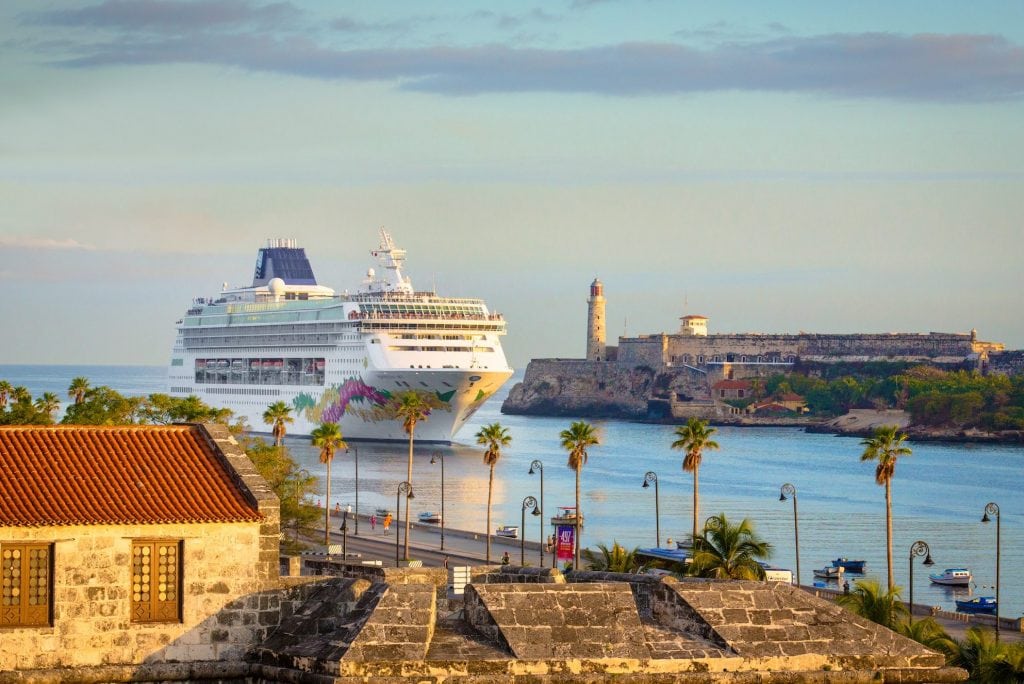Skift Take
The cruise industry has long boasted of its value compared to land vacations. But Norwegian Cruise Line Holdings is notably not emphasizing low prices. It is instead working to get passengers to spend more on tickets, shore excursions, and onboard extras.
Passengers are paying more for their vacations on Norwegian Cruise Line Holdings’ three brands — and the company’s CEO expects that trend to keep going up.
Frank Del Rio told analysts Thursday during a fourth-quarter earnings call that a “strong demand environment” picked up steam throughout 2017 and has continued into the early part of this year.
“Both the number of new bookings sold and the price points achieved reached record levels at each of our three award-winning brands,” he said. The company owns Norwegian Cruise Line, the high-end Oceania Cruises and Regent Seven Seas Cruises, a luxury line.
The world’s third-largest cruise operator reported record booked load factors and pricing so far for each quarter of 2018, and gains even into 2019.
“The real star of the show, going forward, is our pricing power, with all three of our brands showing meaningful year-over-year pricing gains throughout 2018,” Del Rio said.
Since he became CEO in 2015, Del Rio has worked to increase earnings by marketing to fill ships early in the booking cycle, avoiding discounts near the sailing date, offering promotions such as drink or dining packages, and raising prices for tickets and onboard products.
Del Rio said the higher ticket prices that the company has been commanding are a good sign that customers will be eager to spend once they’re on vacation.
“We see a direct correlation between when you have high ticket pricing, you also see high onboard revenue,” he said. “Customers who have money to spend on tickets have money to spend onboard, and we’ve been seeing it throughout 2017 and expect to continue seeing it in 2018.”
For the quarter that ended Dec. 31, revenue increased 9 percent to $1.2 billion compared with the same period a year earlier. Profit for the quarter jumped from $72 million to $99 million.
Full-year revenue was $5.4 billion in 2017, compared to $4.9 billion a year earlier. Profit increased from $633 million in 2016 to $760 million last year.
Very Bullish
Del Rio credited low unemployment, the stock market’s performance, low interest rates, improving economies around the world, and the recent tax law for making the “strong sustained booking environment” possible.
“This year is by far the most excited, most energized and most optimistic I have ever been at the start of a new year,” he said.
But executives cautioned that some things went especially well in 2017 and would be difficult to replicate this year: renewed demand for cruises in Europe after a weak year in 2016 and high prices for the first year of Cuba sailings.
“These significant singular benefits combined contribute to difficult year-over-year yield growth comparisons for 2018,” Del Rio said.
While the company saw adjusted net yields — or revenue generated per person per day — increase about 5 percent in 2017, the increase for this year is only expected to be 2 percent.
Analysts asked if that estimate might be too conservative or easy to beat.
Del Rio said that despite all the positive indications so far, it’s still too early to tell.
Impossible to Predict
“In 2017, the momentum really grew and grew and grew and it wasn’t until the hurricanes hit in mid-September that we had any bump on the road,” he said. “So you tell me how many bumps in the road we’re going to have and I’ll tell you by how much we can possibly beat our guidance.”
Nomura analyst Harry Curtis asked whether the company is concerned — as some investors are — that demand will be high enough to fill new ships over the next couple of years.
Del Rio acknowledged the the company’s capacity growth in 2017 and 2018 was higher than the industry at large, but about half of the industry average for 2019. But he said finding customers for those new ships is not a concern.
“We have so many markets that are either unserved by us or grossly under-penetrated by us,” he said. “We do compete in a global marketplace, but we see so many opportunities to deploy vessels to strong areas, especially in the North American market which is showing very strong secular indications for sustained growth, that we can’t wait to get our hands on new vessels.”
One place those upcoming ships won’t go soon is China. After announcing plans a year ago to send a second ship to China in 2019 — after Norwegian Joy, which launched last year — Del Rio said that is no longer on the horizon.
Norwegian Joy was profitable in 2017, but restrictions on travel to South Korea remain a roadblock and the cruise distribution system in China is “evolving slower than hoped,” Del Rio said.
“Given our fleet size today and the fact that we will only be taking one ship per year, it could be a couple of years before we consider adding more tonnage to China, if the conditions in the rest of the world remain as robust as they are today,” Del Rio said.
The Daily Newsletter
Our daily coverage of the global travel industry. Written by editors and analysts from across Skift’s brands.
Have a confidential tip for Skift? Get in touch
Tags: cruise industry, earnings, ncl, norwegian, norwegian cruise line holdings
Photo credit: High prices on cruises to Cuba helped profit jump for Norwegian Cruise Line Holdings in 2017. In this promotional photo, Norwegian Sky arrives in Havana. Norwegian Cruise Line
